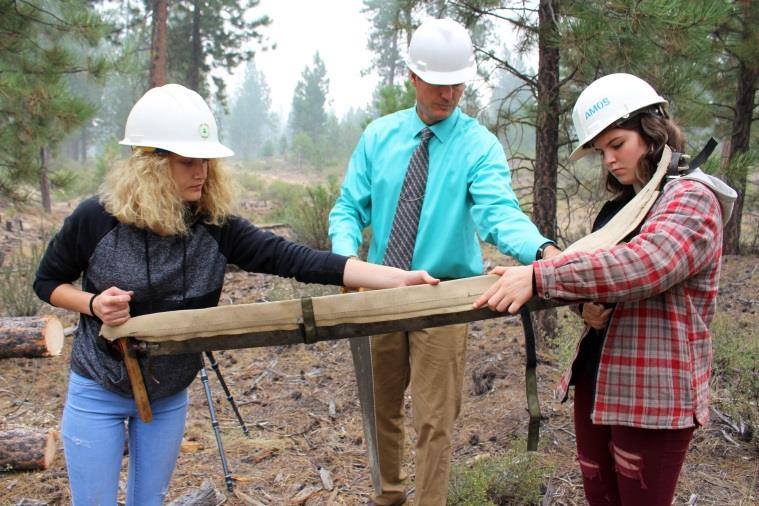Starting the School Year Off with Timber
/Gilchrist School class begins class by felling a tree
GILCHRIST – For students in Brian Wachs’ class, the start of the school year is an adventure. On the second day, students in his woods and metals shop class hike out behind the school.
Their mission? Fell a tree using only hand tools, geometry and math.
“It’s a lot of fun because we get to go out on all these adventures,” said Katie McDaniel, 15, who has been taking Wachs’ classes since seventh grade. “It’s not step one, step two.
You have to figure it out.”
“We get to go out and say, ‘Use your math, use your understanding of what you learned in these classes to make
predictions in real life,” Wachs said. “We know our brains don’t remember all these disjointed facts. We work with context. Being able to look at it causes that lightbulb to come on.”
LIFE LESSONS
On Wednesday, Sept. 6, the Gilchrist students took a two-handed bucksaw to a tree Wachs’ had picked out. They decided which direction they wanted the tree to fall, then began sawing angled cuts into the tree’s trunk to cause it to fall in that specific direction.
Katie said getting out and sawing into a tree was very different from reading about the logging industry in a book.
“Reading about these types of things, especially since logging is a labor job, it doesn’t make sense not to experience it,” she said. “I think it’s better to start it like this because it’s working from the
bottom and making you appreciate the actual process.”
“Having kids ask, ‘Why are we learning this stuff?’ That shouldn’t ever happen,” Wachs said. “By building that umbrella context of felling a tree, and applying geometry and applying those aspects, then it makes sense. They go, ‘Oh! That’s why we’re doing this. That’s why we’re making things happen.”
CONNECTIONS
The town of Gilchrist has a strong history with the timber industry, logging and forestry. Gilchrist was one of the last company towns in Oregon, according to the Oregon Encyclopedia. In 1937 the Gilchrist Timber Company built and founded the town to house a mill, workers’ housing and amenities.
At its height, the company town included a restaurant, cocktail lounge, barbershop, beauty parlor, bowling alley, grocery store,
meat market, post office, library and had a population of about 600 people. With the decline of the logging industry toward the
end of the 20th century, the company sold in 1991 and houses and businesses were sold to individual owners. Though Interfor
Pacific still runs a mill in town, it employs far fewer people than the Gilchrist mill did in its heyday.
Today Gilchrist School, grades K-12, serves a little more than 200 students. The portion of the school housing high school
grades was built in 1938. “There’s such a huge history and important history of Gilchrist being a logging town,” Wachs said. “By us going up and felling trees, being in the woods, that ties them to the history of their town and grounds them in some way.”
It even connects the students to history in the tools they use. Wachs’ doesn’t know how old the two-person bucksaw the class uses is, but admits it bears a strong resemblance to antiques on the walls of some homes.
“That two-man bucksaw, it cuts fast. It does the job well,” he said, and it teaches life lessons to his students. “They’re understanding that the world is not a throw-away society. We can continue to use all these things. Even though they’re old, we can touch them up, we can work with them. We can build things that are made to last.”
BUILDING
When asked if most students start the school year felling a tree, Katie said, “Probably not. Mr. Wachs’ teaching style is not conventional.”
Wachs’ and his students didn’t just fell a tree for the fun of doing it. They will use the wood to make projects. On Wednesday, the students made the exact cuts to send the tree falling precisely where they planned. Next, they brought out the hand saws and continued cutting the trunk into shorter lengths. Later in the week they brought those lengths into the school shop. Through the semester they will plank them and build picture frames.
“They come into my class and they know they are going to get sweaty, they’re going to get dirty,” Wachs said.
His goal?
“Getting them out here and having them actually, real-life apply the math, the science, the geometry, all those different things in real life,” he said. “And be able to produce a real-life product based upon the information they’ve learned in the past.”
Press release and images by:
Samantha Tipler, Public Relations
Klamath County School District




